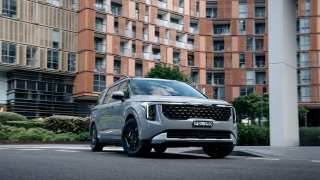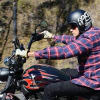
Saab 9-3 2008 Review
- Saab 9-3
- Saab 9-3 2008
- Saab 9-3 Reviews
- Saab Reviews
- Saab Convertible Range
- Saab Coupe Range
- Convertible
- Coupe
- Saab
- Prestige & Luxury Cars
- European

Looking for the “real you” usually involves selling the family wagon and buying a red convertible.
However, after your toupee has been torn from your head, you have been stared and pointed at by giggling schoolgirls, and you have been drenched in the rain when the roof has refused to return to its raised position, you will be ready to sell your convertible and try something else.
At this stage you realise you have wasted a lot of money and tested the patience of your family and friends.
Yet some of us take time to learn and this process can go on for a while as you flit from one midlife crisis purchase to another. There's still a coupe, V8, ute and SUV to try.
I went through the process with a succession of vehicles that I am too ashamed to admit to in public.
My wife would argue that my midlife crisis is still going with my six-monthly turnover of motorcycles, but that's another story. Besides, they're a bit cheaper than cars.
If only I knew then what I know now, I would have saved some money. The lesson is; if you must have a midlife crisis, buy a Saab 9-3 Convertible and get it out of your system.
The Saab is one of the few four-seater convertibles around, which means you can actually justify it as a sort of family car (we won't mention the lack of luggage space).
Saab 9-3 convertibles also have good private resale value, which is absolutely vital, unless you enjoy throwing money down the drain.
And remember, you will pay almost $20,000 more for the convertible over the sedan.
Now Saab has a diesel version, which means it is not only cheap to run but should have an even better residual value when you go to sell it — and you will sell it a seemingly short time after you've had it.
There are stacks of reasons for this.
First, it's a rag top, so you can never be sure about its security. It takes only one brazen thief with a box cutter to get in.
As a rag top, it is also loud, even with the top up, although Saab has a triple-lined rag top, so it's quieter than most.
There is also the problem of handling. Convertibles don't have a roof to take the stresses of the chassis twisting in a corner, so they tend to handle like a leaky boat in a 50-knot wind on Moreton Bay.
The fact it's a four-seater means there's an even bigger non-stressed area of chassis to bend and wave in the breeze.
Saab has greatly improved the handling, but it still is no track-day special.
The main reason for selling the 1.9-litre turbo-diesel model will be that engine.
Yes, it is their most advanced diesel engine yet, with a two-stage turbo, common-rail direct and multiple fuel injection, greater maximum boost pressure, lower compression ratio and alloy cylinder head.
And true, you get about 6.3 litres per 100km fuel economy (which is actually worse than the sedan's 5.8L/100km because the convertible is heavier).
However, that two-stage turbo just doesn't work. In theory it should have no turbo lag. But the lag here is best measured by a calendar.
Don't be tempted to cut into a stream of traffic or you will be left stranded before the boost cuts in just over 2000rpm.
At that point you get peak torque of 320Nm available instantly, which yanks the steering wheel out of your hand and spears the front-wheel driver first one way then another.
If that's not bad enough, the typical clattery noise of the diesel engine is even more evident, either with the top down or up.
Outside, the new model looks much smarter with a few aluminium bits of trim which add to, rather than detract from, the ageing style. Inside is a different story.
Saab's adherence to their traditional aircraft cockpit look is well past its use-by date and the switch gear all feels very light and flimsy.
Admittedly the list of standard features is quite impressive; leather upholstery, heated seats, automatic climate and cruise control and MP3 compatibility.
Our test car included a fully integrated, but retrofitted, Kenwood sat nav and entertainment command centre that Saab is testing for the Australian market.
GM Premium Brands (Saab, Hummer, Cadillac) communications manager Emily Perry said it was a pre-production evaluation unit. “It's not currently available, but we are close to bringing it to market for the 9-3,” she said.
“We hope to have this Kenwood unit available to customers as an accessory by the end of the year. At this stage it's only being tested in the 9-3, not 9-5, but there is a possibility that it may also become available in 9-5. I can't give pricing details or launch timing yet,” she said, although she estimated it would be under $4000.
I have advised Perry that they shouldn't bother, for several reasons.
The navigation function was so difficult to operate, I gave up and used a UBD instead. As for changing radio stations, forget about it.
The screen was almost unreadable in any daytime conditions because of glare. And, although I find touch screens preferable for ease of use, my fingerprints, together with the glare, made it even more difficult to see.
It also reflected the glare off the rear window, which allows little vision because the light blue paintwork on the test model's rear deck directed sunlight straight into it.
There also didn't seem to be any clock in the sat nav unit that I could find, which left the driver with no means of telling the time in the cabin. What is this, a Harley?
I'd stick with the factory-fitted sound system and get a portable sat nav unit.
Snapshot
Saab 9-3 1.9TiD Convertible
Price: $68,000 (Linear), $72,100 (Vector)
Engine: On paper this should be a good unit, but the turbo lag negates the fuel savings. It is also too loud for a soft top.
Handling: The laws of physics are against it from the start.
Economy: The diesel is frugal, but hindered by the heavy convertible body.
Value: Expensive, but you should get good resale value if you look after it.
Body: 2-door, 4-seater convertible
Engine: DOHC, 1910cc, 4-cylinder, common-rail turbo-diesel
Power: 110kW @ 5500rpm
Torque: 320Nm @ 2000-2750rpm
Transmission: 6-speed manual, 6-speed sequential Sentronic auto ($2500), front-wheel drive
Fuel: 6.3L/10km (claimed), 58-litre tank
CO2 emissions: 166g/km (187 auto)
Kerb wieght: 1687-1718kg depending on specification
Tyres: 16 x 6.5 alloys — 215/55 R16 93V; 17 X 7.0 alloys — 225/45 R17 94W; 17 X 7.5 alloys — 235/45 R17 94W; 18 X 7.5 alloys — 225/45 R18 95W, space-saver spare
For: It's a midlife crisis must-have.
Against: Too many to list.
Verdict: The diesel experiment in a convertible just doesn't work.
Pricing guides
Range and Specs
| Vehicle | Specs | Price* | |
|---|---|---|---|
| Turbo X Sportcombi | 2.8L, PULP, 6 SP AUTO | $11,660 – 15,510 | 2008 Saab 9-3 2008 Turbo X Sportcombi Pricing and Specs |
| Turbo X | 2.8L, PULP, 6 SP AUTO | $11,000 – 15,070 | 2008 Saab 9-3 2008 Turbo X Pricing and Specs |
| Linear 2.0T Biopower Sportcomb | 2.0L, PULP, 5 SP MAN | $4,950 – 7,260 | 2008 Saab 9-3 2008 Linear 2.0T Biopower Sportcomb Pricing and Specs |
| Linear 1.9TID | 1.9L, Diesel, 6 SP | $8,800 – 12,430 | 2008 Saab 9-3 2008 Linear 1.9TID Pricing and Specs |
$7,920
Lowest price, based on third party pricing data







